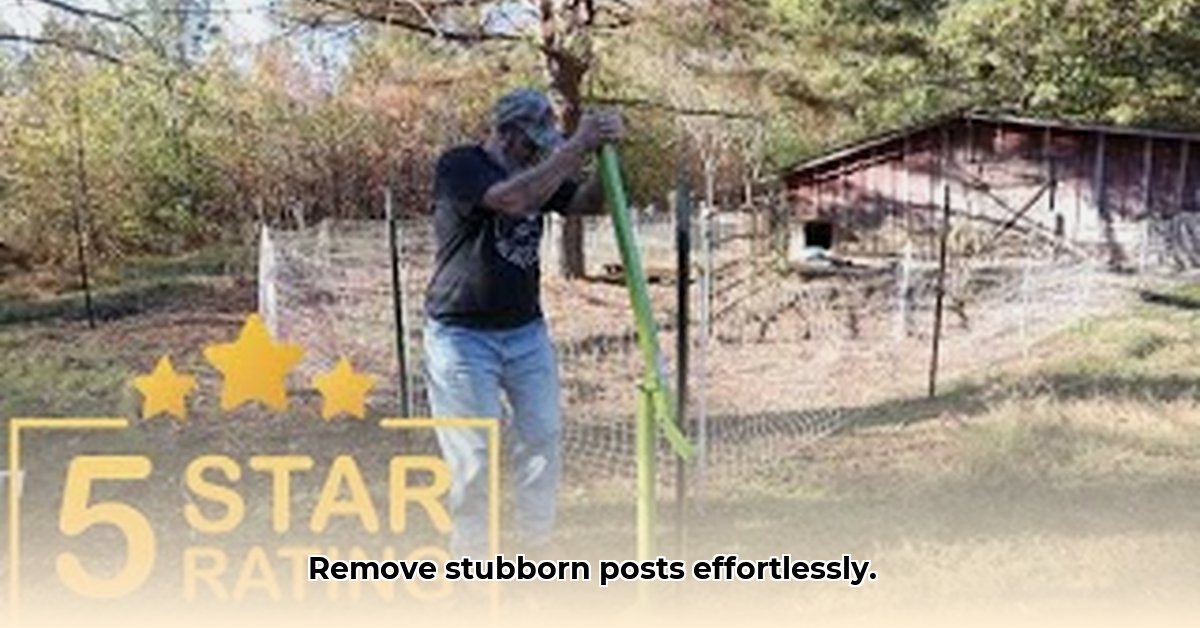
Sustainable farming practices extend beyond crop management to encompass responsible land stewardship. Even seemingly minor tasks, like removing old fence posts, significantly impact your land's long-term health and environmental footprint. This guide provides a comprehensive, actionable approach to sustainable post removal, focusing on efficient techniques and environmentally conscious disposal methods. Utilizing tools readily available at Tractor Supply and similar retailers, this guide will enable you to minimize your environmental impact while maximizing your efficiency.
Tackling Different Fence Post Types: A Practical Approach
Fence posts vary significantly in material and construction, necessitating tailored removal strategies. This section details effective methods for three common types: T-posts, wooden posts, and steel posts. Always prioritize safety by wearing appropriate personal protective equipment (PPE), including gloves and eye protection.
T-Posts: Efficient Removal with Specialized Tools
T-posts are generally easier to remove using a specialized post puller (available at Tractor Supply and similar retailers). This mechanical method significantly reduces labor compared to manual extraction.
- Secure the Grip: Attach the post puller firmly to the T-post, ensuring a secure connection to prevent slippage during extraction.
- Engage the Mechanism: Carefully operate the puller according to the manufacturer's instructions, maintaining a steady pace to minimize soil disturbance.
- Controlled Extraction: Slowly and steadily pull the post, minimizing soil disturbance to preserve soil structure and reduce erosion.
Wooden Fence Posts: Manual Removal Techniques
Wooden posts often require more manual effort. Successful removal necessitates careful excavation to loosen the soil surrounding the post.
- Careful Excavation: Gently dig around the base of the post, being cautious not to damage nearby plants or excessively disrupt the soil.
- Loosening the Grip: Gently rock the post to break the soil's hold. A combination of rocking and slight leverage can effectively loosen the post.
- Extraction: Once sufficiently loosened, cautiously remove the post, minimizing soil erosion and damage to surrounding vegetation.
Steel Fence Posts: Strategies for Heavy-Duty Removal
Steel posts present the most challenging removal scenario due to their robust construction. Heavy-duty equipment may be necessary for efficient extraction.
- Assessment: Before commencing, assess the post's depth and condition to determine the most appropriate equipment and techniques.
- Excavation (If Necessary): For deeply embedded posts, dig around the base to improve access and leverage. A post hole digger can prove invaluable in this step.
- Heavy-Duty Extraction: Employ a heavy-duty post puller or a small excavator for extraction. Remember to prioritize safety and use appropriate safety gear at all times. Could a smaller tractor with attachments suffice?
Environmental Impact: Minimizing Your Footprint
Responsible disposal of old fence posts is crucial for environmental sustainability. Simply dumping treated lumber or steel posts in a landfill is environmentally irresponsible. Prioritize recycling, repurposing, or appropriate alternative disposal methods.
Sustainable Alternatives: Eco-Friendly Post Materials
Biodegradable posts, crafted from materials like bamboo, are gaining popularity as a sustainable alternative. These posts significantly reduce your farm's environmental footprint by minimizing waste and promoting biodegradability. Considering the entire lifecycle of your posts – from installation to disposal – is pivotal for enacting truly sustainable practices.
Best Practices for Sustainable Post Removal
- Minimize Soil Disturbance: Careful post removal techniques protect soil structure and prevent erosion.
- Responsible Disposal: Adhere to local regulations when recycling or disposing of post materials.
- Sustainable Post Selection: Opt for biodegradable or recycled posts to reduce your environmental impact.
- Long-Term Planning: Consider the long-term environmental effects of your post choices and disposal methods.
Choosing the Right Tool: A Comparative Overview
| Post Type | Removal Method | Recommended Tool(s) | Pros | Cons |
|---|---|---|---|---|
| T-Posts | Mechanical | Tractor Supply Post Puller | Efficient, quick, less labor-intensive | Requires specialized tool; potential for minor soil damage |
| Wooden Posts | Manual | Shovel, crowbar, digging bar | Low cost, readily available tools | Labor-intensive, slower, potential for back strain |
| Steel Posts | Mechanical | Heavy-duty post puller, small excavator | Effective for sturdy posts | Can require significant equipment and force; potentially expensive |
Remember, responsible post removal plays a crucial role in advancing sustainable and environmentally friendly farming practices. Investing in the appropriate tools, like a post puller from Tractor Supply or a similar retailer, enhances efficiency and minimizes environmental impact. This ultimately translates into time and cost savings for you.